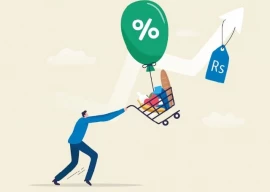
The Pakistani farm, it seems, is ready for the free market.
When it comes to agricultural policy, the government’s efforts over the past five decades can be characterised as a series of well-meaning but ultimately unhelpful (and sometimes even damaging) reforms that focused on trying to control the market. In this special report, The Express Tribune examines the results of those policies and tries to determine what impact they have had.
What we have discovered is astounding. To summarise broadly, whenever the government attempts to control either price or quantity of a particular crop, it only ends up creating the space for unscrupulous middlemen and corrupt government officials to collude in a manner that benefits themselves but to the detriment of both the farmer and the consumer, the two largest classes of people in the country. This is particularly evident in the case of wheat, where farmers rarely ever get the government-announced support price.

On the other hand, when the government seeks to create a fair marketplace, as the government did in 2009 when the Competition Commission of Pakistan forcibly broke up the sugar miller cartel, market forces act in a manner that benefits farmers as well as consumers. After that action, sugarcane farmers were able to command prices higher than government support prices while sugar prices for consumers went down.
Even in the cotton market, where prices are not set by the government, farmers tend to do best when the government does not artificially seek to create a cotton surplus by banning exports. When prices are set by demand and supply and there are no restrictions on where farmers can sell their product, they tend to prosper.

This is not to suggest, of course, that there is no role for the government to play. Agricultural infrastructure is woefully inadequate. Poor irrigation infrastructure, for example, loses the country about 40% of its water supply in an environment where climate change will already exacerbate Pakistan’s water scarcity.
Bad roads and non-existent storage capacity mean that there are several excess layers of intermediaries between the farmer and the consumer, which reduces the available price for the farmer and raises it for the consumer, not to mention causing as much as 40% of the total crop production to go to waste. And poorly defined and enforced agricultural property rights (because of the ill-advised “land reforms”) result in farmers not being able to access credit despite having what should be ample collateral.

What our investigation suggests, however, is that the government seems far too focused on controlling prices and quantities and not enough on creating an efficient market, in which producers, manufacturers, wholesalers, retailers, and consumers interact in a free and fair market, where price signals determine demand and supply.
For the purposes of this report, our analysis is restricted to Punjab. We will cover agriculture in the other provinces, especially Sindh, in later reports, since the dynamics often change depending on region. Nonetheless, the evidence from Punjab seems to suggest that a free, well-regulated market can work well for both farmers and consumers. Announcing high prices for farmers and trying to artificially lowering them for consumers may sound politically pleasing, but is a highly inefficient strategy.
And switching from an administered system to a market-based system need not be painful. The government has already deregulated the price of cotton in 1996 and rice in 1997. Deregulating wheat and sugar prices should, at least in theory, be within the realm of political possibility.

The money saved from trying to subsidise agriculture should instead be spent on improving infrastructure and increasing access to technology for farmers. That is how Brazil went from being a large, poor, agricultural country, to being a global food production powerhouse with a large and rising middle class.
Economic liberalism and the free market have often gotten a bad rap in Pakistan, in part due to their association with the World Bank and the International Monetary Fund, and in part because people often confuse being pro-free markets with being pro-business.
Having free market simply means creating fair rules, and then letting everyone compete. As our special report demonstrates, Pakistani farmers seem to do especially well when we allow that to happen.
Published in The Express Tribune, December 10th, 2012.
COMMENTS (2)
Comments are moderated and generally will be posted if they are on-topic and not abusive.
For more information, please see our Comments FAQ


1725443747-0/Untitled-design-(5)1725443747-0-165x106.webp)














in the name of support price govt has so far looted the poor farmers directly and indirecly....the fed and provincial govts are equally responsible
Great article. ET should also review the traces of "free market" on farmer's income levels and buying power.